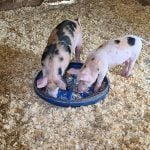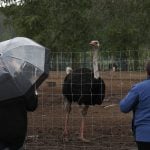Despite the cold and late start to 2008, the season wasn’t one of the worst for pest threats to cereal crops in Western Canada. Then ergot showed up.
The situation may be similar this year, but it will depend on the weather.
Ergot
In 2008, where there was rain there was ergot. And where there was a lot of rain there was a lot of ergot.
Mike Grenier, the Canadian Wheat Board’s senior agrologist, said more than 25 percent of the board’s grain samples contain ergot damage along the Manitoba-Saskatchewan border north of Highway 16.
Read Also

VIDEO: Green Lightning and Nytro Ag win sustainability innovation award
Nytro Ag Corp and Green Lightning recieved an innovation award at Ag in Motion 2025 for the Green Lightning Nitrogen Machine, which converts atmospheric nitrogen into a plant-usable form.
He told producers attending CWB meetings held in Saskatoon as part of Crop Production Week Jan. 10 – 17 that 10 to 20 percent of red spring wheat samples taken in southeastern Saskatchewan contain damage.
Some durum growing areas saw samples with ergot damage as high as 75 percent.
Bruce Carriere of Discovery Seed Labs said his lab is seeing some of the highest levels of infected seed in many years.
“It’s tough to get that out of there.”
Because last year’s crop contained large ergot populations, Grenier said producers need to be aware of the threat that the fungus creates for this year.
“There are no treatments for this pest,” he said.
“Crop rotations and (cultural) management are your only choices. Starting with very clean seed (is important).”
Midge
Grenier said the midge news is good.
“There is less degrading in the 2008 crop than in 2007, and the recent forecast for 2009 shows improvement beyond that.”
Potential problem areas in Saskatchewan include north of Kindersley, north from Davidson to Prince Albert and north of Yorkton, but an increase in midge parasitism cut into populations last fall, which Grenier said will likely reduce populations this year.
“Combine this with the new resistant varieties and we might see some real progress with this pest,” he said.
Sawfly
Grenier said sawfly remains a threat in some areas, but solid stem cereal varieties are an important tool.
“Lillian has been a good example of how well these crops can resist this insect,” he said.
“But if there are high enough populations, that pressure will result in some losses, but only to a point. We are starting to see some parasitism developing in areas where the insect has been a problem and where conditions were dry.”
Problem areas this year include southern Alberta and southwestern Saskatchewan.
Grasshoppers
Grasshoppers caused damage in limited areas in Saskatchewan, with hot spots around Elrose, Sask., near and west of Swift Current, near Davidson and at Southey, north of Regina.
Grasshopper populations are increasing in Manitoba and parts of Saskatchewan, but entomologists don’t expect it to be a peak year for the insect.
Fusarium head blight
Grenier said fusarium head blight was particularly bad in eastern Manitoba last year.
“We don’t call it the Red River Valley of Death for nothing,” he said. “There wasn’t as much as in some years outside of there, but it is still present along the Manitoba and Saskatchewan border and north of Yorkton, with some in southern Alberta. Wherever there is corn residue in the rotation, there is a problem. This is ideal for the pathogen and next year won’t be much different.”
Weather
Bruce Burnett of the CWB said dry conditions in some areas of the Prairies hurt yields last year, and the concern persists this year.
“Dryness continues across Alberta and into northwestern Saskatchewan, and that will be a consideration for the 2009 season’s crop,” Burnett said.
“Especially in southern Alberta, northern Alberta and some parts of Saskatchewan, there are some very serious soil moisture problems. If that doesn’t turn around there will be some problems for those areas’ production in 2009.”
















